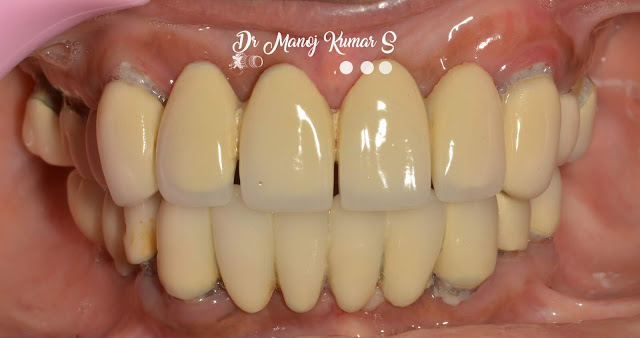Publication 8: Comparison of Marginal Fit of Cast Implant Superstructure Pre- and Post-spark Erosion: An in vitro Pilot Study
Publication 8: Comparison of Marginal Fit of Cast Implant Superstructure Pre- and Post-spark Erosion: An in vitro Pilot Study
Objective: To assess and compare the marginal fit of screw retained three unit implant superstructure, before and after spark erosion.
Methodology: An experimental model was prepared on which three unit screw retained implant superstructure on two implant analogs (cortex system) was fabricated which was then subjected to spark erosion. Sheffield test (one screw test) was carried out to determine the passivity. Assessment of vertical discrepancy was carried out using stereomicroscopic images of the superstructure and implant analog junction pre- and post-spark erosion with the help of image J analysis software.
Results: The implant superstructure fabricated with the conventional casting method were fitting actively on the implant analogs indicating a negative Sheffield test. However, following spark erosion passive fit was achieved. The marginal fit of the cast implant superstructure measured from a reference point on the superstructure to the implant analog margin was 4324.56 μm before spark erosion and 4046.57 μm after spark erosion.
Conclusion: Spark erosion technology with further research can be used to maximum efficiency to obtain passive fit of implant
https://www.semanticscholar.org/paper/Comparison-of-Marginal-Fit-of-Cast-Implant-Pre-and-Lakhanpal-Sundar/516bd369edebfba9de1da0f256b9ae0775ad0825
Objective: To assess and compare the marginal fit of screw retained three unit implant superstructure, before and after spark erosion.
Methodology: An experimental model was prepared on which three unit screw retained implant superstructure on two implant analogs (cortex system) was fabricated which was then subjected to spark erosion. Sheffield test (one screw test) was carried out to determine the passivity. Assessment of vertical discrepancy was carried out using stereomicroscopic images of the superstructure and implant analog junction pre- and post-spark erosion with the help of image J analysis software.
Results: The implant superstructure fabricated with the conventional casting method were fitting actively on the implant analogs indicating a negative Sheffield test. However, following spark erosion passive fit was achieved. The marginal fit of the cast implant superstructure measured from a reference point on the superstructure to the implant analog margin was 4324.56 μm before spark erosion and 4046.57 μm after spark erosion.
Conclusion: Spark erosion technology with further research can be used to maximum efficiency to obtain passive fit of implant
https://www.semanticscholar.org/paper/Comparison-of-Marginal-Fit-of-Cast-Implant-Pre-and-Lakhanpal-Sundar/516bd369edebfba9de1da0f256b9ae0775ad0825



Comments